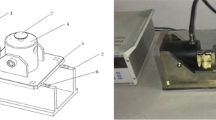Abstract
While moving our fingertip over a fine surface we experience a sensation that gives us an idea of its properties. A satisfactory simulation of this feeling is still an unsolved problem. In this paper, we describe a rendering strategy based on vibrations that play an important role in the tactile exploration of fine surfaces. To produce appropriate excitation patterns we use an array of vibrating contactor pins. Similar to the colour model in computer graphics, we simulate arbitrary vibrations as a superposition of only two sinewaves. Each sinewave is intended for the excitation of a specific population of mechanoreceptors. We carried out first tests of our rendering strategy on Brownian surfaces of different fractal dimensions.
Similar content being viewed by others
References
Bergmann, M., Herbst, I., von Wieding, R., Wolter, F.E.: Haptical rendering of rough surfaces using their fractal dimension. In: Proceedings of the First PHANToM Users Research Symposium, pp. 9–12. German Cancer Research Center, Heidelberg, Germany (1999)
Bernstein, L.E., Eberhardt, S.P., Demorest, M.E.: Single-channel vibrotactile supplements to visual perception of intonation and stress. J. Acoust. Soc. Am. 85, 397–405 (1989)
Bolanowski, S.J., Gescheider, G.A., Verillo, R.T., Checkowsky, C.M.: Four channels mediate the mechanical aspects of touch. J. Acoust. Soc. Am. 84, 1680–1694 (1988)
Cornsweet, T.N.: Visual Perception. Academic Press, New York (1970)
Falconer, K.J.: Fractal geometry: mathematical foundations and applications. Wiley, Chichester (1990)
Foley, J.D., van Dam, A., Feiner, S.K., Hughes, J.H.: Computer Graphics: Principles and Practice, 2nd edn. Addison-Wesley, Reading, MA (1996)
Gescheider, G.A., Bolanowski, S.J., Pope, J.V., Verillo, R.T.: A four-channel analysis of the tactile sensitivity on the fingertip: frequency selectivity, spatial summation, and temporal summation. Somatosens. Mot. Res. 19(2), 114–124 (2002)
Gescheider, G.A., Bolanowski, S.J., Verrillo, R.T.: Some characteristics of tactile channels. Behav. Brain Res. 148, 35–40 (2004)
Handley, C.: The analysis and reconstruction of repetitive textures. In: Proceedings: Computer Graphics International, pp. 273–276, IEEE (1998)
Hollins, M., Bensmaïa, S.J., Washburn, S.: Vibrotactile adaption impairs discrimination of fine, but not coarse, textures. Somatosens. Mot. Res. 18(4), 253–262 (2001)
Huang, G., Metaxas, D., Govindaraj, M.: Feel the ”fabric”: an audio-haptic interface. In: SCA ’03: Proceedings of the 2003 ACM SIGGRAPH/Eurographics Symposium on Computer animation, pp. 52–61. Eurographics Association (2003)
Johnson, K.O.: The roles and functions of cutaneous mechanoreceptors. Curr. Opin. Neurobiol. 11, 455–461 (2001)
Johnson, K.O., Yoshioka, T., Vega-Bermudez, F.: Tactile functions of mechanoreceptive afferents innervating the hand. J. Clin. Neurophysiol. 17(6), 539–558 (2000)
Katz, D.: The World of Touch. Lawrence Erlbaum Associates, Mahwah, MJ (1989)
Kawabata, S.: The standardization and analysis of hand evaluation. Technical Report, The Hand Evaluation and Standardization Committee, The Textile Machinery Society of Japan (1980)
Rao, A.R.: A Taxonomy for Texture Description and Identification, 1st edn. Springer, Berlin Heidelberg New York (1990)
Schulze, M.: Von computergraphischen zu haptischen Texturen. Virtual Reality für den Entwicklungsbereich Design/Styling in der Automobilindustrie. Ph.D. Thesis, Universität Hannover (2005)
Summers, I.R., Chanter, C.M.: A broadband tactile array on the fingertip. J. Acoust. Soc. Am. 112(5), 2118–2126 (2002)
Summers, I.R., Chanter, C.M., Southall, A.L., Brady, A.C.: Results from a tactile array on the fingertip. In: Proceedings of Eurohaptics 2001, pp. 26–28 (2001)
Summers, I.R., Whybrow, J.J., Milnes, P., Brown, B.H., Stevens, J.C.: Tactile perception: comparison of two stimulation sites. J. Acoust. Soc. Am. 118(4), 2527–2534 (2005)
Tsai, P.S., Shah, M.: Shape from shading using linear approximation. Image Vis. Comput. 12(8), 487–498 (1994)
Verrillo, R.T., Fraioli, A.J., Smith, R.L.: Sensation magnitude of vibrotactile stimuli. Percept. Psychophys. 33, 379–387 (1969)
Author information
Authors and Affiliations
Corresponding author
Rights and permissions
About this article
Cite this article
Allerkamp, D., Böttcher, G., Wolter, FE. et al. A vibrotactile approach to tactile rendering. TVC 23, 97–108 (2007). https://doi.org/10.1007/s00371-006-0031-5
Published:
Issue Date:
DOI: https://doi.org/10.1007/s00371-006-0031-5




